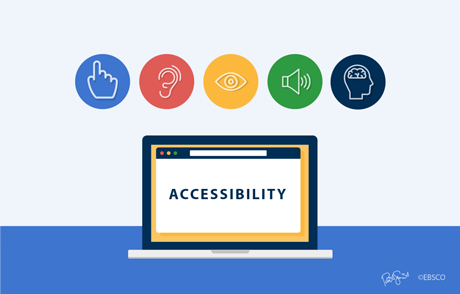Introduction
Technical Communicators need to be aware of accessibility when thinking about the process of UX Design. As a user-centered discipline, UX Designers must remember that currently 57.8 million Americans have one or more disabilities. Among the U.S. veteran population alone, 5.5 million are disabled.5 In a much broader sense, technical communication should be accessible for the World Wide Web with users that fit into the 1 billion people with disabilities (National Center for Disability, 2013).
Accessibility is not confined to a group of users with some different abilities, such as, motor, visual, auditory, speech, or cognitive disabilities. It extends to anyone who is experiencing any permanent, temporary or situational disability. Situational disability refers to someone who may be experiencing a boundary based on the current experience. For example, a person may be situationally one-handed if they are carrying a baby. Design should be mindful of users experiencing a wide variety of daily challenges.

(Source: Microsoft’s inclusive design toolkit)
History
Law
The Web Content Accessibility Guidelines covers a wide range of guidelines in order to make web content accessible for all. There has been recent explosion of ADA web related lawsuits. According to the 2018 ADA Web Accessibility Lawsuit Recap report, lawsuits have increased by 181% from 2017 to 2018, with 2,285 known accessibility UX design related cases. In order to avoid lawsuits and make content easily digestible for all, companies have been pioneering Accessibility teams to make more universal design.
Universal Design
Universal design is the concept that the creation of architecture, products, environments, and content should be accessible for all. With the use of adaptive and assistive technology, website will follow the code of WCAG and universal design concepts.1 The term “universal design” was coined by the architect Ronald Mace to describe the concept of designing all products and the built environment to be aesthetic and usable to the greatest extent possible by everyone, regardless of their age, ability, or status in life. However, it was the work of Selwyn Goldsmith, author of Designing for the Disabled (1963), who really pioneered the concept of free access for people with disabilities.10 His most significant achievement was the creation of the dropped curb – now a standard feature of the built environment.4 Universal design should be applied to technical communication as a method of creating content that is digestible for all.
Pioneers of Change
Microsoft was one of the first pioneers of building an accessibility team. They have developed a handbook of design tools to help make content more accessible for all. They believe that, “inclusive design is a methodology, born out of digital environments, that enables and draws on the full range of human diversity. Most importantly, this means including and learning from people with a range of perspectives.” Since Microsoft’s pushed initiative, many tech companies have been following in making their content and products accessible for all.
Microsoft uses the Persona Spectrum to understand related mismatches and motivations across a spectrum of permanent, temporary, and situational scenarios. It is a quick tool to help foster empathy and to show how a solution scales to a broader audience.

(Source: Microsoft’s inclusive design toolkit)
Accessibility Tools
List of categorial disabilities and tools/rules for each. Remember that some users have situational disabilities as well.
Cognitive
Cognitive disability includes developmental disabilities such as learning difficulties (dyslexia, dysgraphia, ADHD) and cognitive disabilities including Alzheimer’s that may affect memory, attention, developmental maturity, and logical problem solving skills. Users with cognitive impairments may require tools such as:
- Readability formula: https://sites.google.com/a/pdx.edu/technical-communication-topics-wiki/home/readability-metrics
- Text to Speech Features allow audio readers to listen to any written text online
- Font Changer Chrome Extensions: OpenDyslexic
Vision
Vision barriers can include color blindness, low vision, complete blindness and light sensitive epileptics. Technical communicators can make the web more accessible by coding or developing tools that can allow for different forms of visualization.
- High Zoom
- Reverse Contrast (Color contrast can help create better distinction.)
- Consistently Sans-Serif or Serif fonts, not a combination of the two font types
Auditory
Deafness or hearing impairments may make simple tasks such as video content unaccessible. Consider embedding tools that allow for users to read rather than listen.
- Captioning – Transcripts of speech and important sound effects
- Subtitling – Written translation of dialogue
- Language learners, users with cognitive disabilities, or anyone doing the usual page scan for highlights, will find concise journalistic writing helpful (including headings, summaries, images, ect.) As with all web documents, the content should be marked up as standards-focused, semantic, and valid HTML.
Mobility / Motor
Users with mobility difficulties may be unable to use hands due to tremors, loss of fine muscle control, paralysis due to Multiple Sclerosis, Muscular dystrophy, spinal injuries, Parkinson’s disease, and stroke.
- Creating keyboard shortcuts to make more difficult tasks easy.
- Don’t hide important information behind hover-based components.
Mental Health
Mental Health can play a huge barrier to individuals trying live normal lives. Sufferers with PTSD who deal with depression or anxiety may avoid public activities in favor of completing tasks at home. Fully accessible online services are crucial to the lives of these users. Certain accessibility options may be especially beneficial:
- Quick and simple escape options.
- Easy to use User Feedback options.

Content Check
Once content is created, it is important to check to make sure it complies with accessibility regulations. Through the use of user agents and automated testing, a website can be checked for oversights. The AXE Chrome Extension can test the accessibility of a website and target violations that need fixing before publication. Accessibility is achievable with dedication and compassion towards users.
Professional Applications
Accessibility is a niche career path that is rapidly expanding. With accessibility law growing as well, companies are building internal teams to make their products and design usable for the wide variety of customers. Accessibility teams are composed of: technical writers, UX / UI designers, disability specialists, content creators, graphic designers, customer experience and marketing teams.
There are certifications that can make a technical communicator more qualified for the job. The WAS Certification is a credential for professionals who are looking to solve problems related to accessible web solutions. WAS is not focused on writing code, but helped users identify missing or incorrect content.
WAS Exam candidates may be in or aspire to reach these roles their career:
- Accessibility professionals in the areas of web design, development, and programming, whose job requires in-depth knowledge of ICT accessibility standards and regulations.
- Web project managers, designers, developers, and programmers
- User experience designers and testers
- Technical quality assurance (QA) professionals, QA teams and evaluators
- Accessibility and compliance teams and managers
- Web content managers and administrators
- Project, program, and senior ICT managers overseeing initiatives or organizations that focus on web accessibility as a key component of their work.
Any company that is building a website or product must make sure the content is accessibility compliant. With the rapidly growing industry of Accessibility Law, companies are creating accessibility teams within their design department to avoid complications. Accessibility should be something every technical communicator and designer is working towards.
References
[1] Lassen, I. (2003). Accessibility and acceptability in technical manuals: A survey of style and grammatical metaphor (Vol. 4). John Benjamins Publishing.
[2] Meloncon, L. (2018). Orienting Access in Our Business and Professional Communication Classrooms. Business and Professional Communication Quarterly, 81(1), 34-51.
[3] Moehling, J. L., Smith, R. L., Stewart, M. D., & Swenson, J. A. (1999, September). Considering accessibility for visually impaired users [website design]. In IPCC 99. Communication Jazz: Improvising the New International Communication Culture. Proceedings 1999 IEEE International Professional Communication Conference (Cat. No. 99CH37023) (pp. 335-343). IEEE.
[4] Oswal, S. K., & Meloncon, L. (2014). Paying Attention to Accessibility When Designing Online Courses in Technical and Professional Communication. Journal of Business and Technical Communication, 28(3), 271–300. https://doi.org/10.1177/1050651914524780
[5] Oswal, S. K., & Palmer, Z. (2018). Can Diversity Be Intersectional? Inclusive Business Planning and Accessible Web Design Internationally on Two Continents and Three Campuses.
[6] Oswal, S. K. (2013). Exploring accessibility as a potential area of research for technical communication: A modest proposal. Communication Design Quarterly Review, 1(4), 50-60.
[7] Palmer, Z. B., & Palmer, R. H. (2018). Legal and Ethical Implications of Website Accessibility. Business and Professional Communication Quarterly, 81(4), 399-420.
[8] Roberts, L. E. (2006). Using an access-centered design to improve accessibility: A primer for technical communicators. Technical Communication, 53(1), 14-22.
[9] Zdenek, S. (2019). Guest editor’s introduction: reimagining disability and accessibility in technical and professional communication. Communication Design Quarterly Review, 6(4), 4-11.
[10] Wikipedia (2019). Universal Design.
Last updated by Claire Bendig on October 3, 2019.



